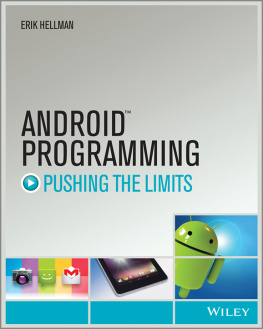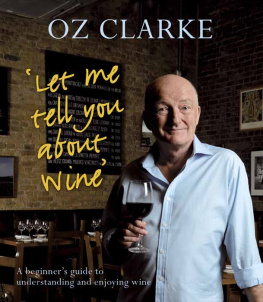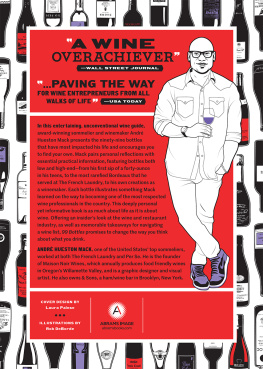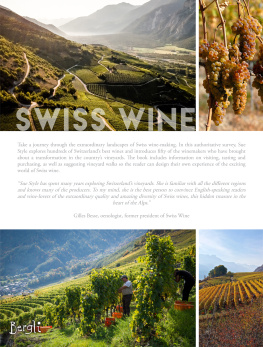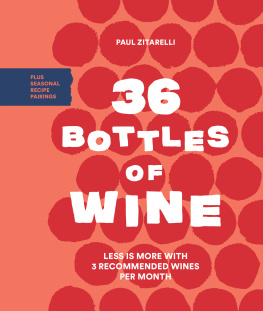About the Author
Peter Hellman, a New Yorkbased journalist and author, has been a contributor to Wine Spectator for more than a decade. His work has also appeared in The New York Times, The Wall Street Journal, New York magazine, and numerous other publications. His books include When Courage Was Stronger than Fear, Chief!, and Fifty Years After Kitty Genovese. He and his wife, Susan, live in New York City, where they raised their children, Jacob and Kate.
PeterHellman.com
ALSO by PETER HELLMAN
Chief! (with Albert Seedman)
When Courage Was Stronger than Fear
American Wine Handbook
The Auschwitz Album (with Lili Meier)
Heroes: Tales from the Israeli Wars
Shaping the Skyline
Fifty Years After Kitty Genovese (with Albert Seedman)
IN VINO DUPLICITAS: The Rise and Fall of a Wine Forger Extraordinaire
Copyright 2017 by Peter Hellman
The are a continuation of this copyright page.
All rights reserved. Except for brief passages quoted in newspaper, magazine, radio, television, or online reviews, no portion of this book may be reproduced, distributed, or transmitted in any form or by any means, electronic or mechanical, including photocopying, recording, or information storage or retrieval system, without the prior written permission of the publisher.
The Experiment, LLC, 220 East 23rd Street, Suite 301, New York, NY 10010-4674
theexperimentpublishing.com
Many of the designations used by manufacturers and sellers to distinguish their products are claimed as trademarks. Where those designations appear in this book and The Experiment was aware of a trademark claim, the designations have been capitalized.
The Experiments books are available at special discounts when purchased in bulk for premiums and sales promotions as well as for fundraising or educational use. For details, contact us at .
Library of Congress Cataloging-in-Publication Data
Names: Hellman, Peter, author.
Title: In vino duplicitas : the rise and fall of a wine forger extraordinaire
/ Peter Hellman.
Description: New York : Experiment, [2017]
Identifiers: LCCN 2017010305| ISBN 9781615193929 (hardcover) | ISBN
9781615193936 (ebook)
Subjects: LCSH: Kurniawan, Rudy, 1976- | Swindlers and swindling--United
States--Biography. | Swindlers and swindling--Indonesia--Biography. | Wine
frauds. | Commercial crimes. | Wine industry.
Classification: LCC HV6692.K87 H45 2017 | DDC 364.16/3--dc23
LC record available at https://lccn.loc.gov/2017010305
ISBN 978-1-61519-392-9
Ebook ISBN 978-1-61519-393-6
Cover design by Sarah Smith
Text design by Sarah Schneider
Author photograph by Dan Sagarin
Manufactured in the United States of America
Distributed by Workman Publishing Company, Inc.
Distributed simultaneously in Canada by Thomas Allen and Son Ltd.
First printing July 2017
10 9 8 7 6 5 4 3 2 1
To Peter Thustrup.
We met as strangers one late morning more than thirty years ago at his Paris rare wine shop. An hour later, we were sipping a wine of his, a 1947 Meursault, at a nearby bistro. And so we bonded. Wine can do that.
Authors Note
This book grew out of a seemingly minor story about the withdrawal of twenty-two lots of wine from an auction in New York in spring 2008. Over the next eight years, I filed dozens of stories in print and online about the making and unmaking of the wine counterfeiter who was the source of those wines. All appeared in Wine Spectator. Those stories would become this books bedrock. Without the support and reach of the magazine, the tale might never have found critical mass. Wine Spectator did for this story what the Washington Post did for Woodward and Bernstein reporting on Watergate and what the Boston Globe did for the reporters who pried open the molestation scandal that later became the basis for the movie Spotlight. I am not so foolish as to think that a tale of fake wine is on par with presidential or priestly misdeeds, but the outcome is similar: Without a publication willing to stay with the story, its not going to reach readers, and the wheels of justice might never start to turn. Google is a wonder. Still, the implosion of print journals since the late 1980s, ranging from the loss of magazines like Life to the diminished page count of The New York Times, makes me appreciate all the more deeply the value of those publications that remain strong and still get printed on paper.
Introduction
I was about to cross Boulevard Raspail in Paris when a silver Renault pulled over. The driver leaned across to open the passenger-side window. His friendly eyes locked on mine. He was in a fix, he told me in good English, without even asking me if that was what I spoke. He was returning from a menswear trade show in Deauville, where he represented the Giorgio Armani line. Somebody had stolen his wallet. Now he was almost out of gas. He needed just a little cash to pay for a couple of liters to get himself home.
Too bad for this fraudster, I thought. Hed picked the wrong guy to be his mark. He wasnt going to scam me. I was about to turn away when he asked me if I was Jewish. The appropriate answer was that it was none of his business. Yet I nodded.
He pointed to a small Star of David dangling on a chain strung from the cigarette lighter on his dashboard. Looking back, Im confident he could have produced a Saint Christophers medal or a Muslim crescent moon and star.
Seeing that I was not reaching for my wallet on his behalf, he said, OK, no problem, sorry to bother you. Enjoy Paris! He started to roll his window up and then, with a sudden bright smile and arch of the eyebrows signifying that he had a great idea, he rolled it back down.
Hey, your sweater size is medium, right? Reaching to the back seat, he grabbed a garment bag bearing the Armani logo. The pale blue sweater within was a sample left over from the show, he explained. He would be getting new samples for the next seasons show, and he no longer needed this one.
Its cashmere, he said. Top quality, double-thick Armani. At Barneys in New York, youd pay six hundred dollars. Youll look great in it.
He thrust the garment bag out the window. I dont want any money from you, he said. It will make me feel really good if you accept it. Americans saved my fathers life in World War II. He was badly wounded by the Germans in 1944 and he was operated on by your army surgeons. Saved his life. Please take this sweater as a token.
My hands, as if on puppet strings, took the bag.
As this generous-spirited stranger started to roll up the window, I felt a pang. How wrong of me to be gifted with an Armani cashmere sweater and give nothing in return!
Hold on, I said, tapping the window to get his attention. From the wallet in my back pocket I pulled out a hundred-franc noteabout twenty dollars in those pre-euro days. This will get you a little gas.
He grabbed the money. Up went the window and he sped off. Not even a thank-you. I sensed that he was already scanning the pedestrians, looking for his next American.
Inside the zipper bag was a cheesy polyester rag, nasty to the touch. I pitched it into a trash can. Unexpectedly, I felt admiration for this now-departed master of manipulation. Hed pushed buttons in my psyche even as I was aware that he was doing it, yet I was powerless to disconnect. It was a performance worth the price of admission.
Push the right buttons in people who think they are too savvy to be fooled, as the master counterfeiter who is the subject of this book did repeatedly, and what is billed as the rarest of wines can be sold to marks for a far higher price than the rarest cashmere. The wealthy collectors who spent millions on those fake wines were canny fellows in their businesses. Yet, in the hands of this unlikely con man, they did as I had done: They responded to his perceived generosity by opening their wallets.
Next page

